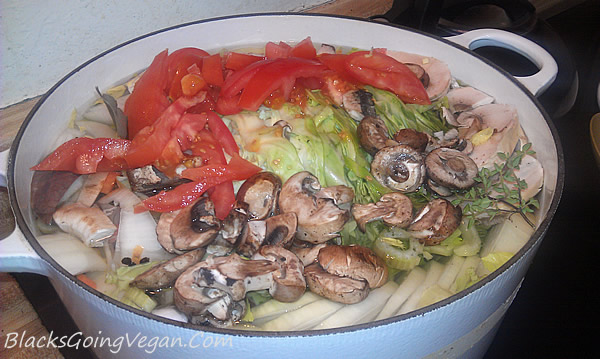Rich and Flavorful Vegetable Stock Recipe
Vegetable stock is a key ingredient in many vegan and vegetarian recipes. I do a lot of cooking, and if you notice, most of the recipes posted here call for some kind of vegetable stock or vegan imitation meat flavoring. I keep vegetable stock, vegan beef style, and vegan chicken style stock cubes on hand, and use them quite often. I’ve also been known to buy the quart sized cartons of organic vegetable or not-chicken broth when they’re on sale 2/$4 or 2/$5, just to put them in my pantry for the proverbial “rainy day.”
However, it occurred to me that I was really being (1) lazy, and (2) cash wasteful to buy vegetable stock. I mean, I can see running to the store if one is in a pinch, have no instant bouillon powder or cubes and don’t have two hours to make your own stock.
But if you have the time, why spend all that money when you can easily make your own vegetable broth for pennies? Not only that, you can control what is in the broth, and avoid sodium, additives such as MSG, preservatives.
Vegetable Stock Adds Flavor
Whether omnivore or vegan, the tastiest results for any dish are obtained when a flavorful stock is used vs just plain water. Vegetable stock can be used to water saute your vegetables (saves calories!), or to cook rice, millet, beans, soups and stews, stir-frys, gravy and sauces, quinoa, potatoes, collard greens or cabbage… the opportunities to bump up the flavor of your food by using stock are endless.
Honey, if you aren’t on the stock bandwagon yet, you need to be! Watch your dishes go from “meh” to memorable.
Before you get an attitude and start mumbling horrible things about me (“this woman is always trying to keep somebody in the damn kitchen!”), let me tell you that making a vegetable stock is ridiculously easy. Once you get the stuff in the pot, it cooks itself and you can go catch your favorite show or something.
Easy Techniques for Making Vegetable Stock
There are three popular approaches to making vegetable stock:
- Throw everything in the pot, set it on simmer, and sit down for an hour or so;
- Roast ALL the vegetables in the oven at 350 degrees for 25-30 minutes, then throw everything in the pot, set it on simmer, and sit down for an hour or so; or
- Saute your aromatics first, then throw everything in the pot, set it on simmer, and sit down for an hour or so.
I actually prefer the latter method, and start my vegetable stock making process by sauteing then caramelizing the carrots, celery and onions to a toasty golden brown. Caramelizing onions eliminates any possible bitterness, and helps bring out their full sweetness. If you want a lighter colored stock or are too busy with other things, use method #1 (pictured below).
This recipe produces a rich, golden colored vegetable stock that will enhance the smell and flavor of any recipe you use it in. I find it easiest to divide the stock up into recipe use proportions (about four cups), and stick them in the freezer. I do that by sitting a freezer bag in a tall bowl, then use a measuring cup to measure out how much I want in the bag.
Be sure to label the contents and add the date so you can be sure to use your vegetable stock within six months. Mine never lasts that long, however.
Any vegetable stock left after I bag some for my freezer (usually about a quart) I stick in a Mason jar or Tupperware, and pop it into the fridge for immediate use.
Learn From My Vegetable Stock Mistakes
Here are a few other tips for making vegetable stock that I’ve learned through trial and error.
- Though many cookbooks and recipes say to cut your vegetables into large pieces, I’ve found that a small chop or thin slice is better (between 1/4″ to 1″ in size). You can use your food processor and chop the vegetables if you like, or just chop them into bite sized pieces by hand. The more surface area of the veggies in contact with the water, the more the flavors are extracted into the broth.
- Some people use the old dried up or wilted vegetables in their refrigerator for stock. To me that is gross, so I always start my stock off with fresh vegetables and use the old veggies in my garden compost instead. If you have lots of vegetable scraps, you can put them in a large freezer bag as you go through the week, which will keep them fresh until you are ready to make your stock.
- As I said above, sauteing the onions, celery and carrots before adding them to the stock pot brings out their sweetness and makes the broth taste just that much better. Plus the broth turns a beautiful honey gold color.
- Remove the outer leaves of celery before you chop it up… they’ll make the stock bitter (the tender inner leaves are another story). Bitterness will result if you use broccoli, Brussels sprouts, cauliflower, artichokes, or mustard green stems, too.
- I prefer not to use green bell peppers in stock either (red, yellow or orange are okay). To me the green peppers impart a really bitter taste.
- Mushrooms are super great in vegetable stock, and add a fabulous savory flavor. Try using baby bella, Shiitake, or my favorite porcini mushrooms. Don’t be shy about adding a couple of handfuls.
- Organic vegetables are best. You don’t have to worry about peeling anything, just scrub with a vegetable brush and chop.
- Make sure the water you start with is cold. Add all the vegetables to your stock pot, THEN turn on the heat so that everything warms up together. Turn the fire on high and get the vegetable stock to boiling temperature, then immediately reduce it to a simmer and let it do its thing.
- Add your salt and pepper at the end, after you’ve strained the broth. A little bit at a time will keep you from over-salting, and in the event you have someone in your home on a “no added sodium” diet, salt can be added at the table to the finished dish. If that isn’t a concern, then throw it on in the pot as the broth cooks.
A Recipe is Merely a Starting Point!
Feel free to experiment with the vegetables you use in your vegetable stock – leeks are a great addition, as is white wine, rosemary or other herbs, green beans, etc.
The main thing you want to do is keep the flavors balanced, so don’t go overboard adding too much of one type of vegetable, or it will dominate the stock and take over any dish you make with it.

- 2-3 Tablespoons olive oil
- 3 stalks celery, cut into ½" slices
- 2 Turkish bay leaves
- ½ pound mushrooms, sliced
- 20 peppercorns
- 4 large carrots, cut into ¼" slices
- 2 medium tomatoes, cut into 1" chunks
- ½ head green cabbage, sliced thin (1/2")
- 3 sweet yellow or Spanish onions, peeled and sliced thin
- 1 whole head garlic, cloves broken apart and skin removed
- 6 sprigs of fresh thyme
- sea or kosher salt to taste
- fresh ground black pepper to taste
- 16 cups of water
- In a large pot, add olive oil and turn to medium heat. Toss in the sliced onions, sliced carrots, and chopped celery. Saute for about 5 minutes or until the onions start to become translucent.
- Cover pot and reduce the heat to medium-low to sweat the vegetables for about 30 minutes, or until the onions caramelize and turn golden brown.
- Add 4 quarts of water (16 cups), and the remaining ingredients. Cover pot, reduce heat to low and simmer for 60-90 minutes.
- Remove from heat and allow pot to cool. Then strain the stock in a colander, somewhat mashing the vegetables against the sides of the colander to extract all the stock liquid.
- Store in airtight container in the refrigerator for immediate use, or divide up and freeze for later.
Get exciting new soul food, Cajun/Creole and classic American recipes done vegan! Check out WHY VEGAN IS THE NEW BLACK: More than 100 Meat and Dairy Free Meal Ideas Your Whole Family Will Love.
Category: Condiments and Seasonings






























